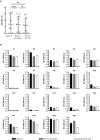The Major Peanut Allergen Ara h 2 Produced in Nicotiana benthamiana Contains Hydroxyprolines and Is a Viable Alternative to the E. Coli Product in Allergy Diagnosis
- PMID: 34671372
- PMCID: PMC8522509
- DOI: 10.3389/fpls.2021.723363
The Major Peanut Allergen Ara h 2 Produced in Nicotiana benthamiana Contains Hydroxyprolines and Is a Viable Alternative to the E. Coli Product in Allergy Diagnosis
Abstract
Peanut allergy is a potentially life-threatening disease that is mediated by allergen-specific immunoglobulin E (IgE) antibodies. The major peanut allergen Ara h 2, a 2S albumin seed storage protein, is one of the most dangerous and potent plant allergens. Ara h 2 is posttranslationally modified to harbor four disulfide bridges and three hydroxyprolines. These hydroxyproline residues are required for optimal IgE-binding to the DPYSPOHS motifs representing an immunodominant IgE epitope. So far, recombinant Ara h 2 has been produced in Escherichia coli, Lactococcus lactis, Trichoplusia ni insect cell, and Chlamydomonas reinhardtii chloroplast expression systems, which were all incapable of proline hydroxylation. However, molecular diagnosis of peanut allergy is performed using either natural or E. coli-produced major peanut allergens. As IgE from the majority of patients is directed to Ara h 2, it is of great importance that the recombinant Ara h 2 harbors all of its eukaryotic posttranslational modifications. We produced hydroxyproline-containing and correctly folded Ara h 2 in the endoplasmic reticulum of leaf cells of Nicotiana benthamiana plants, using the plant virus-based magnICON® transient expression system with a yield of 200 mg/kg fresh biomass. To compare prokaryotic with eukaryotic expression methods, Ara h 2 was expressed in E. coli together with the disulfide-bond isomerase DsbC and thus harbored disulfide bridges but no hydroxyprolines. The recombinant allergens from N. benthamiana and E. coli were characterized and compared to the natural Ara h 2 isolated from roasted peanuts. Natural Ara h 2 outperformed both recombinant proteins in IgE-binding and activation of basophils via IgE cross-linking, the latter indicating the potency of the allergen. Interestingly, significantly more efficient IgE cross-linking by the N. benthamiana-produced allergen was observed in comparison to the one induced by the E. coli product. Ara h 2 from N. benthamiana plants displayed a higher similarity to the natural allergen in terms of basophil activation due to the presence of hydroxyproline residues, supporting so far published data on their contribution to the immunodominant IgE epitope. Our study advocates the use of N. benthamiana plants instead of prokaryotic expression hosts for the production of the major peanut allergen Ara h 2.
Keywords: Ara h 2; Nicotiana benthamiana; PTM; hydroxyproline; peanut allergy; transient expression.
Copyright © 2021 Üzülmez, Kalic, Mayr, Lengger, Tscheppe, Radauer, Hafner, Hemmer and Breiteneder.
Conflict of interest statement
The authors declare that the research was conducted in the absence of any commercial or financial relationships that could be construed as a potential conflict of interest.
Figures





Similar articles
-
Allergenicity of peanut component Ara h 2: Contribution of conformational versus linear hydroxyproline-containing epitopes.J Allergy Clin Immunol. 2015 May;135(5):1267-74.e1-8. doi: 10.1016/j.jaci.2014.10.025. Epub 2014 Dec 4. J Allergy Clin Immunol. 2015. PMID: 25483599
-
Ara h 8, a Bet v 1-homologous allergen from peanut, is a major allergen in patients with combined birch pollen and peanut allergy.J Allergy Clin Immunol. 2004 Dec;114(6):1410-7. doi: 10.1016/j.jaci.2004.09.014. J Allergy Clin Immunol. 2004. PMID: 15577846 Clinical Trial.
-
Expression of a codon-optimised recombinant Ara h 2.02 peanut allergen in Escherichia coli.Appl Microbiol Biotechnol. 2016 Jan;100(2):661-71. doi: 10.1007/s00253-015-6953-y. Epub 2015 Sep 28. Appl Microbiol Biotechnol. 2016. PMID: 26411458
-
Redefining the major peanut allergens.Immunol Res. 2013 Mar;55(1-3):125-34. doi: 10.1007/s12026-012-8355-x. Immunol Res. 2013. PMID: 22948807 Free PMC article. Review.
-
Posttranslational modifications of heterologous proteins expressed in Nicotiana benthamiana.Plant Biotechnol J. 2025 Jun 8. doi: 10.1111/pbi.70176. Online ahead of print. Plant Biotechnol J. 2025. PMID: 40483572 Review.
Cited by
-
Legumain Functions as a Transient TrkB Sheddase.Int J Mol Sci. 2023 Mar 11;24(6):5394. doi: 10.3390/ijms24065394. Int J Mol Sci. 2023. PMID: 36982466 Free PMC article.
-
Implications of O-glycan modifications in the hinge region of a plant-produced SARS-CoV-2-IgA antibody on functionality.Front Bioeng Biotechnol. 2024 Mar 6;12:1329018. doi: 10.3389/fbioe.2024.1329018. eCollection 2024. Front Bioeng Biotechnol. 2024. PMID: 38511130 Free PMC article.
-
Microarray-based evaluation of selected recombinant timothy grass allergens expressed in E. Coli and N. Benthamiana.BMC Biotechnol. 2024 Oct 4;24(1):72. doi: 10.1186/s12896-024-00902-0. BMC Biotechnol. 2024. PMID: 39367362 Free PMC article.
-
Gut microbial bile and amino acid metabolism associate with peanut oral immunotherapy failure.Nat Commun. 2025 Jul 9;16(1):6330. doi: 10.1038/s41467-025-61161-x. Nat Commun. 2025. PMID: 40634275 Free PMC article. Clinical Trial.
-
Isolation, Characterization and IgE Binding of Two 2S Albumins of Pomegranate Seeds.Foods. 2024 Jun 21;13(13):1965. doi: 10.3390/foods13131965. Foods. 2024. PMID: 38998471 Free PMC article.
References
Grants and funding
LinkOut - more resources
Full Text Sources
Molecular Biology Databases
Research Materials

